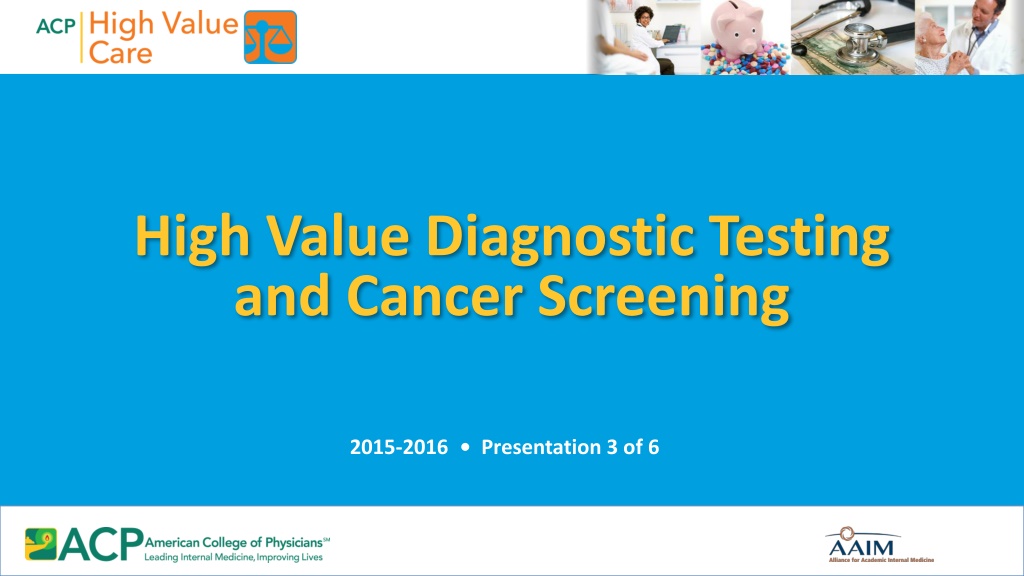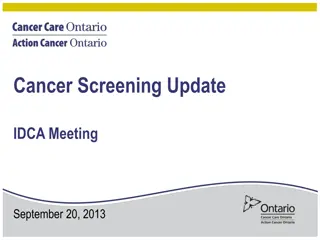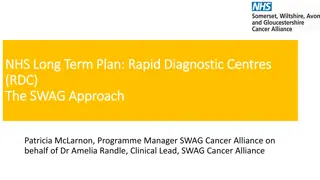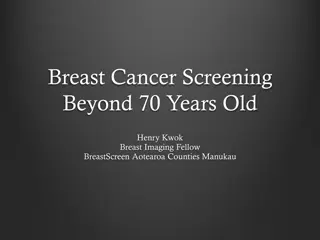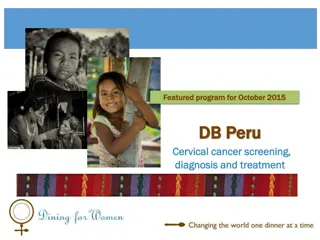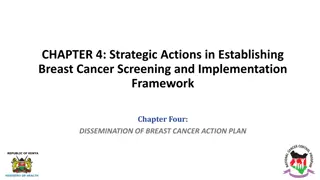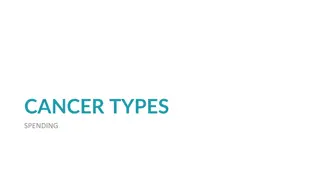Understanding High-Value Diagnostic Testing and Cancer Screening
Review key biostatistical concepts including sensitivity, specificity, positive predictive value, and negative predictive value to make informed decisions in high-value care. Learn how to customize screening recommendations based on individual risk factors and values, considering benefits, harms, and costs of routine screening.
- Diagnostic testing
- Cancer screening
- Biostatistical concepts
- High-value care
- Screening recommendations
Download Presentation

Please find below an Image/Link to download the presentation.
The content on the website is provided AS IS for your information and personal use only. It may not be sold, licensed, or shared on other websites without obtaining consent from the author. Download presentation by click this link. If you encounter any issues during the download, it is possible that the publisher has removed the file from their server.
E N D
Presentation Transcript
High Value Diagnostic Testing and Cancer Screening 2015-2016 Presentation 3 of 6
Learning Objectives Review sensitivity, specificity, and predictive value and their applicability to high value care. Practice applying these concepts to support high value care decisions when considering diagnostic and screening tests. Explore the benefits and harms (including cost) of routine screening. Develop an approach to customize screening recommendations to an individual patient and his/her unique risk factors, values, and concerns.
Brief Review of Biostatistical Concepts1 Sensitivity The ability to detect people who do have disease Specificity The ability to detect people who do not have disease Positive Predictive Value (PPV) The likelihood that a person with a positive test result actually has disease Negative Predictive Value (NPV) The likelihood that a person with a negative test result truly does not have disease
Sensitivity Be sensitive to those who have disease Disease Positive Disease Negative True Positive Test Positive True Positive False Positive True Positive + False Negative Test Negative False Negative True Negative
Specificity Negative people get specific Disease Positive Disease Negative True Negative Test Positive True Positive False Positive True Negative + False Positive Test Negative False Negative True Negative
PPV Disease Positive Disease Negative True Positive Test Positive True Positive False Positive True Positive + False Positive Test Negative False Negative True Negative
NPV Disease Positive Disease Negative True Negative Test Positive True Positive False Positive True Negative + False Negative Test Negative False Negative True Negative
Diagnostic Testing Pretest Probability Diagnostic Test Posttest Probability Disease prevalence Sensitivity, specificity PPV, NPV
Role of Diagnostic Tests To reduce uncertainty regarding a specific patient s diagnosis Generally most appropriate for patients you feel have an intermediate (10%-90%) pretest probability of a disease Test characteristics (such as likelihood ratios) should be considered before ordering a test to help determine whether a given test would significantly alter your posttest probability (and thus affect management).
Likelihood Ratios Using likelihood ratios: 1. Use the estimated pretest probability of disease as an anchor on the left side of the graph. 2. Draw a straight line through the known likelihood ratio, either (+) or (-). 3. Where this line intersects the graph on the right represents the posttest probability of disease.
Positive Likelihood Ratio of Common Physical Exam Maneuvers2 Fluid wave for ascites: Valgus laxity for MCL injury: Homan s sign for DVT: Nuchal rigidity for meningitis: 5.0 146.5 1.1 3.0
Diagnostic Testing Likelihood Ratio Pretest Probability Diagnostic Test Posttest Probability Disease prevalence Sensitivity, specificity PPV, NPV
Approach To PE: Small Group Exercise Break into 3 small groups. Each group will work through a different case of a patient with possible pulmonary embolism. Focus on the diagnostic process: Estimate the pretest probability of disease in your patient. Evaluate how D-dimer testing or CTA in your patient would influence your posttest probability of disease and assess whether these test would be helpful in your patient.
Role of Screening Tests To detect asymptomatic and early-stage disease Should be highly sensitive and highly specific to pick up most cases of true disease and avoid false positives Targeted toward populations with a higher disease prevalence (high positive predictive value) Should be relatively safe and cost-effective Should screen for diseases in which early identification and treatment have been demonstrated to improve clinical outcomes
Common Harms Associated with Screening False positive results Primary goal of screening: find cancer maximize sensitivity at cost of specificity False positives Can lead to incorrect labeling, inconvenience, expense, and physical harm in follow-up tests
Common Harms Associated with Screening Lead-Time Bias: Make diagnosis of cancer, but no mortality benefit Length-Time Bias: Overdiagnosis and Pseudodisease
Screening Value Cases Discuss the following screening cases, and use handout to guide your decisions: 45-year-old woman asking about mammography 70-year-old man with ESRD on HD, CAD, COPD, and uncontrolled DM asking for colonoscopy 35-year-old woman, new patient, had a negative Pap smear 2 years ago, now asks for a repeat Pap test because that s what she s always had
Screening Smarter Screen less frequently. Don t screen patients with a life expectancy less than 10 years. Discuss potential downstream testing with patient before ordering initial screening test. Use higher threshold for positive result. Understand basic test characteristics and limitations as well as an individual patient s goals and values.
Cost-effectiveness4 Cost-saving Reduces cost, Costs money, Costs money, Improves health Improves health Worsens health Measures that cost money but improve health can be further categorized by their cost, often measured in dollars per QALY (quality-adjusted life-year). QALYs incorporate an estimate of the quantity of life gained by the intervention, coupled with a more subjective assessment of the quality of that life affected by the intervention. Historically, payers have considered any intervention that has a cost-effectiveness ratio of <$100K per QALY as acceptable.
Cost Effectiveness of Selected Treatments5,6 Cost-saving (ratio of <$0): Aspirin for at-risk patients, childhood immunizations 0 to $13,999/QALY: Chlamydia screening, colorectal screening for all adults >50 $14,000 to $34,999/QALY: Cervical cancer screening, hypertension screening (all adults) >$35,000/QALY: Mammography
Lung Cancer Screening and QALY7 Recent study from Nov. 2014 NEJM examined the QALY for low-dose CT screening for lung cancer. Study found that screening for lung cancer with low- dose CT would cost $81,000 per QALY gained, below the $100K cut-off. Some concern that outside study, costs will go up (different institutions with different prices for CT, increased follow-up testing, etc.)
Summary Diagnostic tests should only be used if the result is likely to significantly affect your certainty of a disease (posttest probability) and should rely on likelihood ratios for a given test when available. The goals of screening are to detect treatable, asymptomatic, or early stage disease. The limitations (lack of sensitivity/specificity) and cost-effectiveness of screening tests, as well as patients goals, should be taken into account before ordering. Recommendations are not prescriptive, but rather the beginning of an open dialogue with patients to create (as a team) a prioritized plan of preventive health maintenance.
References Glaser AN. High-Yield Biostatistics. 3rd ed. Philadelphia: Lippincott Williams and Wilkins; 2004. McGee S. Evidence-Based Physical Diagnosis. Philadelphia: Elsevier Saunders; 2012. Harris RP, Wilt TJ, Qaseem A; High Value Care Task Force of the American College of Physicians. A value framework for cancer screening: advice for high-value care from the American College of Physicians. Ann Intern Med. 2015 May 19; 162:712-7. [PMID: 25984846] Owens, D, Qaseem A, Chou R, Shekelle P; Clinical Guidelines Committee of the American College of Physicians. High-value, cost-conscious health care: concepts for clinicians to evaluate the benefits, harms, and costs of medical interventions.Ann Intern Med. 2011 Feb 1;154(3):174-80. [PMID: 21282697] Cohen JT, Neumann PJ, Cohen JT, Neumann PJ, Weinstein MC. Does preventive care save money? Health economics and the presidential candidates. N Engl J Med. 2008 Feb 14;358(7):661-3. [PMID: 18272889] Institute of Medicine. The Healthcare Imperative: Lowering Costs and Improving Outcomes: Workshop Series Summary. Washington DC: National Academics Press; 2010 1. 2. 3. 4. 5. 6.
References 7. Pinsky, Paul F. Cost-effectiveness of CT screening in the National Lung Screening Trial. New Engl J Med. 2015 Jan 22;372(4):387. Moynihan R, et al. Preventing overdiagnosis: how to stop harming the healthy. BMJ. 2012;344: e3502. [PMID: ] Wilt TJ, Harris RP, Qaseem A; High Value Care Task Force of the American College of Physicians. Screening for cancer: advice for high-value care from the American College of Physicians. Ann Intern Med. 2015 May 19;162(10):718-25. [PMID: 25984847] Welch HG, Schwartz L, Woloshin S. Overdiagnosed: Making People Sick in the Pursuit of Health. Boston, MA: Beacon Press; 2011. Moriates C, Arora V, Shah, N. Understanding Value-Based Healthcare. New York: McGraw- Hill Education; 2015. 8. 9. 10. 11.
